Papers by Aliz Judit Ernyey
Frontiers in Pharmacology

Physiology International
Our aim was to establish a pharmacologically induced neurovascular uncoupling (NVU) method in rat... more Our aim was to establish a pharmacologically induced neurovascular uncoupling (NVU) method in rats as a model of human cognitive decline. Pharmacologically induced NVU with subsequent neurological and cognitive defects was described in mice, but not in rats so far. We used 32 male Hannover Wistar rats. NVU was induced by intraperitoneal administration of a pharmacological “cocktail” consisting of N-(methylsulfonyl)-2-(2-propynyloxy)-benzenehexanamide (MSPPOH, a specific inhibitor of epoxyeicosatrienoic acid-producing epoxidases, 5 mg kg−1), L-NG-nitroarginine methyl ester (L-NAME, a nitric oxide synthase inhibitor, 10 mg kg−1) and indomethacin (a nonselective inhibitor of cyclooxygenases, 1 mg kg−1) and injected twice daily for 8 consecutive days. Cognitive performance was tested in the Morris water-maze and fear-conditioning assays. We also monitored blood pressure. In a terminal operation a laser Doppler probe was used to detect changes in blood-flow (CBF) in the barrel cortex whi...
European Neuropsychopharmacology, 2021
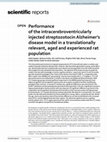
Scientific Reports
The intracerebroventricularly (icv) injected streptozotocin (STZ) induced brain state is a widely... more The intracerebroventricularly (icv) injected streptozotocin (STZ) induced brain state is a widely used model of sporadic Alzheimer-disease (AD). However, data have been generated in young, naive albino rats. We postulate that the translationally most relevant animal population of an AD model should be that of aged rats with substantial learning history. The objective of the study was thus to probe the model in old rats with knowledge in various cognitive domains. Long-Evans rats of 23 and 10 months age with acquired knowledge in five-choice serial reaction time task (5-CSRTT), a cooperation task, Morris water-maze (MWM) and “pot-jumping” exercise were treated with 3 × 1.5 mg/kg icv. STZ and their performance were followed for 3 months in the above and additional behavioral assays. Both STZ-treated age groups showed significant impairment in the MWM (spatial learning) and novel object recognition test (recognition memory) but not in passive avoidance and fear conditioning paradigms (...
European Neuropsychopharmacology, 2021
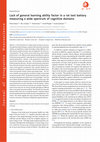
Journal of Integrative Neuroscience, 2022
In the framework of a larger project aiming to test putative cognitive enhancer drugs in a system... more In the framework of a larger project aiming to test putative cognitive enhancer drugs in a system with improved translational validity, we established a rodent test battery, where di ferent, clinically relevant cognitive domains were investigated in the same animal population. The aim of the current study was to check whether performances in the di ferent tasks representing di ferent cognitive functions are assay-specific or may originate in an underlying general learning ability factor. Methods: In the experiments 36 Long-Evans and 36 Lister Hooded rats were used. The test battery covered the following cognitive domains: attention and impulsivity (measured in the 5-choice serial reaction time task), spatial memory (Morris watermaze), social cognition (cooperation task), cognitive lexibility (attentional set shi ting test), recognition memory (novel object recognition) and episodic memory (water-maze based assay). The outcome variables were analyzed by correlation analysis and principal component analysis (PCA). The datasets consisted of variables measuring learning speed and performance in the paradigms. From the raw variables composite variables were created for each assay, then from these variables a composite score was calculated describing the overall performance of each individual in the test battery. Results: Correlations were only found among the raw variables characterizing the same assay but not among variables belonging to di ferent tests or among the composite variables. The PCAs did not reduce the dimensionality of the raw or composite datasets. Graphical analysis showed variable performance of the animals in the applied tests. Conclusions: The results suggests the assay outcomes (learning performance) in the system are based on independent cognitive domains.
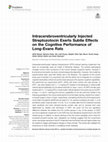
Frontiers in Pharmacology, 2021
Intracerebroventricularly injected streptozotocin (STZ)-induced learning impairment has been an i... more Intracerebroventricularly injected streptozotocin (STZ)-induced learning impairment has been an increasingly used rat model of Alzheimer disease. The evoked pathological changes involve many symptoms of the human disease (cognitive decline, increase in β-amyloid and phospho-tau level, amyloid plaque-like deposits). However, the model has predominantly been used with Wistar rats in the literature. The objective of the current study was to transfer it to Long-Evans rats with the ulterior aim to integrate it in a complex cognitive test battery where we use this strain because of its superior cognitive capabilities. We performed two experiments (EXP1, EXP2) with three months old male animals. At EXP1, rats were treated with 2 × 1.5 mg/kg STZ (based on the literature) or citrate buffer vehicle injected bilaterally into the lateral ventricles on days 1 and 3. At EXP2 animals were treated with 3 × 1.5 mg/kg STZ or citrate buffer vehicle injected in the same way as in EXP1 at days 1, 3, and...

Brain Research Bulletin, 2020
INTRODUCTION The serial clinical failures of novel cognitive enhancer candidates point out the la... more INTRODUCTION The serial clinical failures of novel cognitive enhancer candidates point out the lack of predictive power in the preceding animal experimentation. For a more predictive profiling of putative procognitive drugs in rodents, we recently elaborated a methodical approach which consists of three fundamental steps: 1. teaching various learning tasks representing different cognitive domains to the same cohort of animals with the aim to create a population with 'widespread knowledge'. 2. Applying a cognitive deficit-inducing intervention to transform this cohort of animals to a 'patient population'. 3. Testing putative procognitive drugs with a 'clinical trial-like' design on the wide spectrum of cognitive (dys)functions in the actual 'patient population'. The present study has been the first trial to test the feasibility and utility of the proposed system. METHODS The population with 'widespread knowledge' consisted of 2 year old male Long-Evans rats with a learning history in five-choice serial reaction time task (5-CSRTT, attentional paradigm), Morris water maze (MWM, spatial learning), a cooperative task carried out in pairs (social learning), and a skill-learning task, "pot-jumping". For inducing cognitive deficit, thus creating a 'patient population' we increased the difficulty of the tasks. For the cognitive enhancer mechanism to test in the system we chose a serotonin 5-HT6 receptor antagonist compound, RO4368554. Animals were randomly assigned to vehicle- and drug treated groups based on their baseline learning performance and their response in a pilot test of increase in task difficulty. During the 13-day long treatment with 3 mg/kg ip. RO4368554 all the learning paradigms were repeatedly run with increased difficulty supplemented with a novel object recognition test (NOR, episodic memory). RESULTS In the 5-CSRTT, reducing the stimulus duration from 1 s to 0.25 s caused a significant decrease in the percentage of correct responses (from 52% to 31% in the control group) which was not affected by the 5-HT6 receptor antagonist treatment (correct responses decreased from 58% to 31%). In the MWM, replacing the escape platform to a new location did not mean a hard challenge for the rats. Members of both groups could find it within a relatively short time: mean escape latencies were 83 s and 65 s at the first replacement trial and 58 s and 74 s at the second one in the control and drug-treated groups, respectively. In the cooperation paradigm, where the rats had to perform simultaneous nose-pokes to get a reward, task difficulty was increased by requiring two consecutive simultaneous nose-poking from the animals. This caused a fall in the percentage of successful trials in both groups (from 48% to 12% and from 50% to 20% in the saline - and drug-treated group, respectively), however, by the end of the treatment RO4368554-treated animals showed significantly higher performance (29%) than saline treated rats (2%). The NOR test, carried out with a 5 -h delay, revealed poor recognition memory in both groups (discrimination index (DI) values were 0.13 and 0.06 for saline and RO4368554, respectively). Performance in the pot jumping test was also not improved by the drug-treatment. CONCLUSIONS The applied study design allowed parallel measurements of the action of the test compound on several cognitive functions and to follow its time course. RO4368554 did not show notable effects on impaired attention and visual recognition; nor did it affect spatial and procedural learning, but it exerted beneficial effect on cooperative behaviour. The revealed activity pattern highlight the cognitive domain most sensitive to the particular drug effect and may give hints for further target validating and clinical studies.
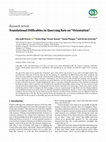
BioMed Research International, 2019
The aim of this study was to translate the “orientation” query of the ADAS-Cog inventory to rats ... more The aim of this study was to translate the “orientation” query of the ADAS-Cog inventory to rats and to investigate whether they can determine which time of the day they are. For this purpose, we established a modified Morris water-maze navigation task where the escape platform was placed onto various locations at different times of the day: “morning”, “noon” and “evening”. In each of these sessions rats swam a “query” trial and a “confirmatory” trial, 30 min apart. Lister Hooded rats randomly chose among the three possible target locations, while Long Evans rats partly followed a win-stay strategy by preferring to visit first to the platform position of the previous session. Despite simplifying the task to a morning–evening discrimination, Lister Hooded rats continued searching by chance, while Long Evans rats switched to the mentally less demanding random strategy. We then inserted a board into the pool which required longer swimming path from the animals when they were correcting...
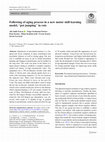
GeroScience, 2019
Impairment of procedural memory is a frequent and severe symptom in many neurological and psychia... more Impairment of procedural memory is a frequent and severe symptom in many neurological and psychiatric diseases as well as during aging. Our aim was to establish an assay in rats in which procedural learning and changes in performance can be studied on the long term. The work was done in the frame of a larger project aiming to establish a complex cognitive animal test battery of high translational value. The equipment was a 190-cm-diameter circular water tank where 12 flower pots were placed upside down in a circle with increasing distances (18-46 cm) between the adjacent ones. Male Lister Hooded and Long-Evans rats were allowed to move on the pots for 3 min. The arena was filled with shallow water to make the rats stay on the pots. Animals were obviously motivated to move around on the pots; however, the distance which required jumping (> 26 cm) meant a barrier for some of them. Development of motor skill was measured by the longest distance successfully spanned. A relatively flat bell-shaped age dependence was observed, with a peak at 13 months of age. A gradual decline in performance could be observed after the age of 20 months which preceded the appearance of overt physical weakness. Long-Evans rats showed more homogeneous performance and higher individual stability than Lister Hooded rats. The method is appropriate to study the development of motor learning and to follow its age-dependent changes. It may also serve as an assay for testing potential drugs for improving motor skills and/or procedural memory.
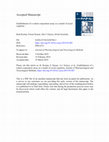
Journal of Pharmacological and Toxicological Methods, 2019
Introduction: Impaired cooperative skills form a characteristic symptom in autism, which lacks ad... more Introduction: Impaired cooperative skills form a characteristic symptom in autism, which lacks adequate treatment. The objective of this study was to establish a rat cooperation assay which fits the feasibility and capacity requirements of drug development. Methods: Long-Evans and Lister Hooded rats were trained in pairs to simultaneously perform nose-pokes (within 1 s) for reward in a Skinner box equipped with two nose-poke modules. Conditioning took place first with naive-naive pairs, then with naive-experienced and finally with experienced-experienced pairs, when the task was familiar for both rats. In a control experiment, experienced Lister-hooded pairs were tested under the learnt schedule but without the possibility to communicate with each other. Results: Rats were able to learn the task in 8-15 sessions. Experienced-experienced Long-Evans pairs completed the training significantly faster than the other pairs Analysis of the nose-poke latency data, sample video-recordings and the significantly decreased performance of rats in the control experiment suggested that the animals solved the task via real cooperation. Discussion: The newly developed rat cooperation model is quick and has sufficiently high throughput, therefore it may be used in the drug development of putative social cognitive enhancer compounds.
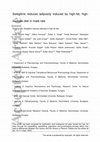
British journal of pharmacology, Jan 3, 2018
Incidence and severity of obesity is increasing worldwide. To date, efficient and safe pharmacolo... more Incidence and severity of obesity is increasing worldwide. To date, efficient and safe pharmacological tools to treat or prevent obesity have not been developed. Certain monoamine-oxidase (MAO) inhibitors have been shown to reduce body weight, although their effect on metabolic parameters have not been investigated. Here we assessed the effect of a widely used, selective MAO-B inhibitor, selegiline, on metabolic parameters in high-fat, high-sucrose diet-induced rat model of obesity. Male Long-Evans rats were fed with control (CON) or high-fat (20%), high-sucrose (15%) diet (HFS) for 25 weeks. From week 16 groups of animals received subcutaneous injections of 0.25 mg kg selegiline (CON+S and HFS+S) or vehicle (CON, HFS) once daily. Selegiline decreased whole body fat, subcutaneous and visceral adiposity as measured by computer tomography and epididymal fat weight in the HFS group as compared to HFS placebo animals without influencing body weight. Oral glucose tolerance test and insul...
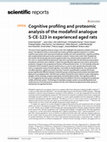
Scientific Reports, 2021
The lack of novel cognitive enhancer drugs in the clinic highlights the prediction problems of an... more The lack of novel cognitive enhancer drugs in the clinic highlights the prediction problems of animal assays. The objective of the current study was to test a putative cognitive enhancer in a rodent cognitive test system with improved translational validity and clinical predictivity. Cognitive profiling was complemented with post mortem proteomic analysis. Twenty-seven male Lister Hooded rats (26 months old) having learned several cognitive tasks were subchronically treated with S-CE-123 (CE-123) in a randomized blind experiment. Rats were sacrificed after the last behavioural procedure and plasma and brains were collected. A label-free quantification approach was used to characterize proteomic changes in the synaptosomal fraction of the prefrontal cortex. CE-123 markedly enhanced motivation which resulted in superior performance in a new-to-learn operant discrimination task and in a cooperation assay of social cognition, and mildly increased impulsivity. The compound did not affect...
Uploads
Papers by Aliz Judit Ernyey